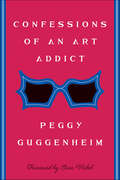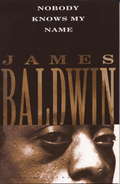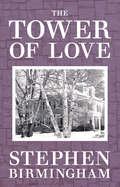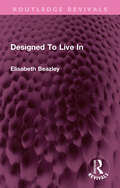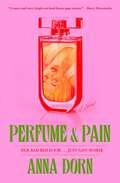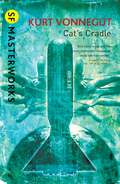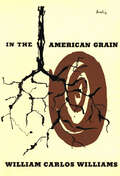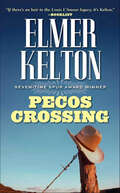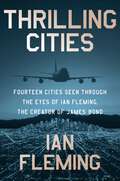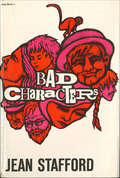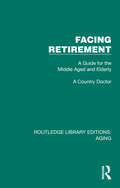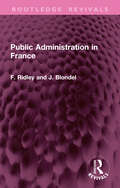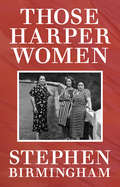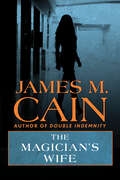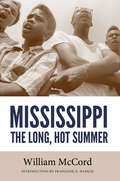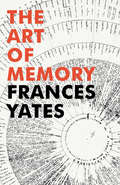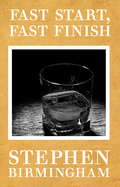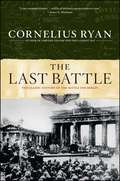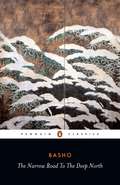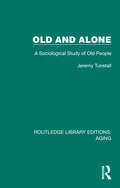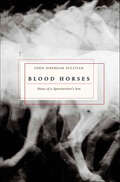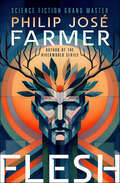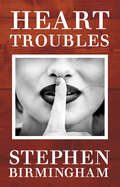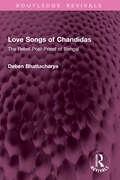- Table View
- List View
Confessions of an Art Addict
by Peggy GuggenheimA patron of art since the 1930s, Peggy Guggenheim, in a candid self-portrait, provides an insider's view of the early days of modern art, with revealing accounts of her eccentric wealthy family, her personal and professional relationships, and often surprising portrayals of the artists themselvesPeggy Guggenheim was born into affluence and a lavish lifestyle. Bored with her seemingly "pedestrian" life in New York, she headed for Europe in 1921, where she woudl sow the seeds for a future as one of modern art's most important and influential figures.In the midst of Europe's avant-garde circles, she reveled in her love affairs with prominent artists and also became a serious collector. Her Guggenheim Jeune gallery in London brought figures such as Brancusi, Cocteau, Kandinsky, and Arp to the forefront of the art scene. Later, her New York gallery would launch the careers of Jackson Pollock and Robert Motherwell, among others.In her own inimitable and bawdy style, Peggy Guggenheim gives us an insider's glimpse into the modern art world with intimate, often surprising portrayals of its most significant players. Candid, clever, and always entertaining, here is a memoir that captures a valuable chapter in the history of modern art, as well as the spirit of one of its greatest advocates.
Nobody Knows My Name: Notes Of A Native Son / Nobody Knows My Name / The Fire Next Time / No Name In The Street / The Devil Finds Work (Vintage International #1)
by James BaldwinFrom one of the most brilliant writers and thinkers of the twentieth century comes a collection of "passionate, probing, controversial" essays (The Atlantic) on topics ranging from race relations in the United States to the role of the writer in society.Told with Baldwin's characteristically unflinching honesty, this &“splendid book&” (The New York Times) offers illuminating, deeply felt essays along with personal accounts of Richard Wright, Norman Mailer and other writers. &“James Baldwin is a skillful writer, a man of fine intelligence and a true companion in the desire to make life human. To take a cue from his title, we had better learn his name.&” —The New York Times
The Tower of Love
by Stephen BirminghamBack at his family&’s New England estate, a man finds a second chance at love—and a devastating truth—in this novel by the author of Young Mr. Keefe. At thirty-one years of age, Hugh Carey has ended both his marriage and his advertising partnership. With his life at loose ends, he&’s returned to the family home in Connecticut—that imposing castle built by his grandfather—to take stock and start over. His mother is only too happy to offer her counsel, as she does for Hugh&’s sister Patsy. But her reputation as the most effective woman since Lady MacBeth is well earned. Also delighted to have Hugh back is Edrita Everett Smith. She&’s the girl next door—and the one who got away. As Hugh and Edrita reconnect, it seems that little has changed, and their old romance is ready to blossom again. But in this quiet, well-heeled suburb, nothing is as simple as it seems. As buried jealousies come to light and new schemes are hatched, Hugh will learn what it truly takes to forge his own path.
Designed To Live In (Routledge Revivals)
by Elisabeth BeazleyOriginally published in 1962, this book traces the main influences behind modern design in domestic architecture. It does so against the context of the effect each new dwelling has on its environment and the effect its design has on those in the surrounding (and often older, historic) housing stock. Diverse influences such as the bye-law street and Le Corbusier’s Ville Radieuse are discussed, while the ideas bearing on the individual private house range from those of the early nineteenth century villa builders to Frank Lloyd Wright’s prairie houses and the work of Mies van der Rohe. The book closes with a detailed discussion of the problems and possibilities of domestic design in house-building in the late 20th Century
Perfume and Pain: A Novel
by Anna Dorn&“Perceptive and witty—like a Sally Rooney novel set in Southern California.&” —Star Tribune (Minneapolis) &“It&’s this author&’s best work yet. A Sapphic roller-coaster ride.&” —Kirkus Reviews (starred review) A controversial LA author attempts to revive her career and finally find true love in this hilarious nod to 1950s lesbian pulp fiction.Having recently moved both herself and her formidable perfume bottle collection into a tiny bungalow in Los Angeles, mid-list author Astrid Dahl finds herself back in the Zoom writer&’s group she cofounded, Sapphic Scribes, after an incident that leaves her and her career lightly canceled. But she temporarily forgets all that by throwing herself into a few sexy distractions—like Ivy, a grad student researching 1950s lesbian pulp who smells like metallic orchids, or her new neighbor, Penelope, who smells like patchouli. Penelope, a painter living off Urban Outfitters settlement money, immediately ingratiates herself in Astrid&’s life, bonding with her best friends and family, just as Astrid and Ivy begin to date in person. Astrid feels judged and threatened by Penelope, a responsible older vegan, but also finds her irresistibly sexy. When Astrid receives an unexpected call from her agent with the news that actress and influencer Kat Gold wants to adapt her previous novel for TV, Astrid finally has a chance to resurrect her waning career. But the pressure causes Astrid&’s worst vice to rear its head—the Patricia Highsmith, a blend of Adderall, alcohol, and cigarettes—and results in blackouts and a disturbing series of events. Unapologetically feminine yet ribald, steamy yet hilarious, Anna Dorn has crafted an exquisite homage to the lesbian pulp of yore, reclaiming it for our internet and celebrity-obsessed world. With notes of Southern California citrus and sultry smokiness, Perfume and Pain is a satirical romp through Hollywood and lesbian melodrama.
Cat's Cradle (S.F. MASTERWORKS #70)
by Kurt VonnegutOne of America's greatest writers gives us his unique perspective on our fears of nuclear annihilationExperiment.Told with deadpan humour and bitter irony, Kurt Vonnegut's cult tale of global destruction preys on our deepest fears of witnessing Armageddon and, worse still, surviving it.Solution.Dr Felix Hoenikker, one of the founding fathers of the atomic bomb, has left a deadly legacy to the world. For he is the inventor of ice-nine, a lethal chemical capable of freezing the entire planet. The search for its whereabouts leads to Hoenikker's three eccentric children, to a crazed dictator in the Caribbean, to madness. Felix Hoenikker's death-wish comes true when his last, fatal, gift to mankind brings about an end that, for all of us, is nigh.
In the American Grain (Second Edition)
by William Carlos WilliamsA new edition of William Carlos Williams’ loving and groundbreaking book about American history, with a new introduction by Rick Moody. Although admired by D. H. Lawrence, this modern classic went generally unnoticed during the years after its publication in 1925. Yet it is “a fundamental book, essential if one proposes to come to terms with American literature” (Times Literary Supplement). William Carlos Williams was not a historian, but he was fascinated by the texture of American history. Beginning with Columbus’s discovery of the Indies and moving on through Sir Walter Raleigh, Cotton Mather, Daniel Boone, George Washington, Ben Franklin, Aaron Burr, Edgar Allan Poe, and Abraham Lincoln, Williams found in the fabric of familiar episodes new shades of meaning and configurations of character. He brought a poetic imagination to the task of reconstructing a live tradition for Americans, and what results is one of the finest works of prose to have been penned by any writer of the twentieth century.
Pecos Crossing: Two Complete Novels Of The American West
by Elmer KeltonJohnny Fristo and Speck Quitman, young, hard-working cowboys from Fort Concho, Texas, have worked six months--at $20 a month--on the Devil's River. Their boss, a hawk-faced cow trader named Larramore, reneges on the money he owes the boys and sneaks out of the cow camp and heads for San Angelo.Fristo is tall and thin, his mind a hundred miles away; Quitman is short, bandy-legged, and "bedazzled by the flash of cards and the slosh of whiskey." The two are as different as sun and moon but are inseparable—and now they have a mission: find Larramore and extract the money he owes them.At the Publisher's request, this title is being sold without Digital Rights Management Software (DRM) applied.
Thrilling Cities: Fourteen Cities Seen Through the Eyes of Ian Fleming, the Creator of James Bond
by Ian FlemingA CAPTIVATING JOURNEY AROUND THE WORLD FROM THE CREATOR OF JAMES BONDIan Fleming’s world travels and interests, as well as his journalism and wartime experiences, lent authority to everything he wrote. In 1959, the Sunday Times commissioned Fleming to write a series of dispatches from the world’s most beguiling locales. The result was Thrilling Cities, a masterpiece of well-observed travelogue that stands ably alongside the author’s Bond canon.From Hong Kong to Honolulu, New York to Naples, he left the bright main streets for the back alleys, abandoning tourist sites in favor of underground haunts, and mingling with celebrities, gangsters and geishas. The result is a series of vivid snapshots of a mysterious, vanished world from a twentieth century Western perspective.Just like his most famous fictional creation, Ian Fleming was a well-traveled man of the world who knew where to go to find excitement, adventure…and danger. In Thrilling Cities, he takes us along on a journey of international intrigue worthy of James Bond.
Bad Characters: Stories
by Jean StaffordThis book displays at their height the wit, sensibility and psychological penetration that distinguish Miss Stafford's work. There are nine stories and a novella. They range in mood from the title story, a comic portrait of a resourceful child-criminal named Lottie Jump, to "The End of a Career," an elegiac and ironic tale of the declining years of a great beauty. In "A Reasonable Facsimile" Dr. Bohrmann, a retired professor philosophy, is unexpectedly rescued from an aggressively boring young house guest. "Cops and Robbers" is a chilling story of childhood horror and lovelessness that revolves around a father's trip to the barber with his five-year-old daughter.Several of the stories have as their common setting Miss Stafford's fiction town of Adams, Colorado—including an amusing saga of a girl's frustrated attempts to find a quiet spot to read ("A Reading Problem"), and two stories of failure ("In the Zoo") and success ("The Liberation") in the effort to escape from one's family. "Caveat Emptor" is a satire on the academic life and sub-life at the Alma Hettrick College for Girls; and in "The Captain's Gift" the sheltered and lavender-scented existence of old Mrs. Ramsey is violated by the reality of war.The major piece in Bad Characters is "A Winter's Tale," a haunting and evocative novella set in Heidelberg just before the outbreak of the war. It is dominated by the diabolic character of Frau Professor Persis Galt. This portrait of a former Bostonian who poses as an excessively devout convert is one of Miss Stafford's most brilliant fictional creations.This collection by Jean Stafford will be warmly welcomed by the many and devoted admirers of her novels and stories. To new readers the work of one of the best writers of our time will come as a joyful discovery.
Facing Retirement: A Guide for the Middle Aged and Elderly (Routledge Library Editions: Aging)
by A Country DoctorOriginally published in 1960 and revised in 1964 the blurb for Facing Retirement read:“Mature men and women are not afraid of advancing years. More and more seek to prepare themselves for retirement so that they may then find all the happiness they can.This phase of life is interesting to a widening circle, and in writing this book it was the author’s aim to discuss readably, simply, and from his experience with his patients, most relevant aspects of these later years. It was a pioneer in its approach: any similar books which may follow, if they help to lessen the burden of the elderly and aged which has to be sustained by the younger generations, must be of the highest importance not only to individuals but to the nation.For nearly thirty years the author of this book has had the medical care of over 2,000 people of all ages in a cluster of villages and hamlets at the foot of the Cotswold Hills. He has been chairman or president of the County Association for the Care of old People since its inception in 1952.”Today it can be read and enjoyed in its historical context.
Public Administration in France (Routledge Revivals)
by F. F. Ridley J. BlondelOriginally published in 1964, this book was an important addition to the growing field of comparative government and administration. This book covers the organisation of the French cabinet, the structure and functions of government departments and of local authorities, the civil service, the police, the judiciary and public enterprise. There are also chapters on economic planning, the administration of social services and of the educational system. The book explains the spirit as well as the mechanism of the French administrative system, the principles that underly it and the wider background against which it is set
Those Harper Women
by Stephen BirminghamFour generations of women grapple with the gilded cage of their family dynasty in this #1 New York Times–bestselling author&’s &“big, bustling novel&” (The New York Times). Meredith Harper made millions in rum before Prohibition ruined the market. When he died, he left behind an estate of such vast wealth that his descendants were set for life—but what sort of life would it be? In Those Harper Women, Stephen Birmingham presents a fictional group portrait of women who pass down both fortunes and misfortunes, who want for nothing save happiness. Across generations, the Harper women seek joy, self-fulfillment, or mere escape from the trappings of their privilege. But through trips to Europe and the Caribbean, through marriage and divorce, the women find themselves returning time and again to the looming shadow of Meredith and his money.
The Magician's Wife
by James M. CainFor the love of a beautiful waitress, a meat salesman will turn butcher in this crime thriller by “one of the greats of American noir” (The Guardian).Clay Lockwood. is a top distributing executive with Grant’s Meats, and the contract with the Portico restaurant chain is only the latest in a long line of boardroom coups. He arrives at the Portico for lunch, and eats his fill of his company’s beef, but leaves with an entirely different hunger gnawing at his gut—a volcanic passion that will tear him apart. Lockwood is mesmerized by hostess Sally Alexis, a magician’s wife. She rebuffs his first pass, but calls him up later…. Although Sally’s marriage is miserable, she won’t leave her husband in order to secure an inheritance for her little boy. And as the lovers get closer, Lockwood becomes an amateur illusionist himself, focusing on one very particular deadly trick—how to make a magician disappear.“James M. Cain is one novelist who has something to teach just about any writer, and delight just about any reader.” —Anne Rice, #1 New York Times–bestselling author of Interview with a Vampire
Mississippi: The Long, Hot Summer (Civil Rights in Mississippi Series)
by William McCordIn 1964, sociologist William McCord, long interested in movements for social change in the United States, began a study of Mississippi's Freedom Summer. Stanford University, where McCord taught, had been the site of recruiting efforts for student volunteers for the Freedom Summer project by such activists as Robert Moses and Allard Lowenstein. Described by his wife as “an old-fashioned liberal,” McCord believed that he should both examine and participate in events in Mississippi. He accompanied student workers and black Mississippians to courthouses and Freedom Houses, and he attracted police attention as he studied the mechanisms of white supremacy and the black nonviolent campaign against racial segregation. Published in 1965 by W. W. Norton, his book, Mississippi: The Long, Hot Summer, is one of the first examinations of the events of 1964 by a scholar. It provides a compelling, detailed account of Mississippi people and places, including the thousands of student workers who found in the state both opportunities and severe challenges. McCord's work sought to communicate to a broad audience the depth of repression in Mississippi. Here was evidence of the need for federal action to address what he recognized as both national and southern failures to secure civil rights for black Americans. His field work and activism in Mississippi offered a perspective that few other academics or other white Americans had shared. Historian Françoise N. Hamlin provides a substantial introduction that sets McCord's work within the context of other narratives of Freedom Summer and explores McCord's broader career that combined distinguished scholarship with social activism.
Another Spring
by Loula Grace ErdmanLong lines of refugees wind their way through all of recorded history. Today, numbered in the millions, the dispossessed wander across most of the countries of the earth. Here is an eloquent and dramatic novel about some exiles of the American past, victims of Order Number Eleven. On a hot August day in 1863, the military order was posted in four western counties of Missouri, banishing by Federal edict all inhabitants, sympathizers of the Union as well as the Confederacy. Harried by roaming hostile bands, their homes burned, thousands fled the proscribed area. Taking only the barest necessities, the Weatherlys and the Nichols joined the crowds jamming the dusty roads. They were rich landowners and, despite the conflict in loyalties, friends. The bond between them was strengthened by the engagement of Richard Nichols and the Weatherlys’ niece Betsey. And then there were the Carroways, neighbors, too, but strangers, separated by a gulf of caste and privilege. Yet it was Lura Carroway’s brother Pete who was to play a decisive role in the future of the little group. The troubled days of the exodus began -- of being rejected and driven on, of living off the land, of hunger and numbing fatigue. Crises and danger from secret enemies lay ahead of them. Life itself would depend on their being able to forget their old ways, on their ability to change. But the journey into fear would be a journey of self-discovery, of tragedy balanced by hope. And for some of them, love would come. It would not have the romantic background of balls and parties that young Susan Nichols had been brought up to expect, but against the shadows it would cast a stronger light. Miss Erdman writes with authority of a period and a place that she knows well. Her novel Many A Voyage was about Kansas during that dark and bloody era of warfare between the two states. Now, in Another Spring she has told a compelling story about a group of exiles bound together in a struggle for survival--a story that is as timely as the accounts of the refugees of today.
The Art of Memory
by Frances A YatesThis unique and brilliant book is a history of human knowledge. Before the invention of printing, a trained memory was of vital importance. Based on a technique of impressing 'places' and 'images' on the mind, the ancient Greeks created an elaborate memory system which in turn was inherited by the Romans and passed into the European tradition, to be revived, in occult form, during the Renaissance. Frances Yates sheds light on Dante’s Divine Comedy, the form of the Shakespearian theatre and the history of ancient architecture; The Art of Memory is an invaluable contribution to aesthetics and psychology, and to the history of philosophy, of science and of literature.
Fast Start, Fast Finish
by Stephen BirminghamA family man risks everything to pursue his artistic dreams, in this novel of marriage, betrayal, and suburban malaise by the author of The Auerbach Will. California art director Charlie Lord has all the makings of a surefire winner. But despite his good looks, wit, and sophistication, his track record shows a series of blazing starts followed by fast, ego-crushing finishes. His marriage to Nancy, complete with three almost grown-up children and an elegant house in an exclusive suburb, gave him all the trappings of happiness. Still, none of these things can satisfy Charlie&’s dreams of success on a grand scale. Now he&’s off and running once again—taking his family across the country to New York, where he hopes to further his career as an artist. But Charlie soon finds himself submerged in a sea of troubles . . . and a fevered love affair that threatens to destroy his life.
The Last Battle: The Classic History of the Battle for Berlin (A History Bestseller)
by Cornelius RyanThe classic account of the final offensive against Hitler&’s Third Reich.The Battle for Berlin was the culminating struggle of World War II in the European theater, the last offensive against Hitler&’s Third Reich, which devastated one of Europe&’s historic capitals and marked the final defeat of Nazi Germany. It was also one of the war&’s bloodiest and most pivotal battles, whose outcome would shape international politics for decades to come. The Last Battle is Cornelius Ryan&’s compelling account of this final battle, a story of brutal extremes, of stunning military triumph alongside the stark conditions that the civilians of Berlin experienced in the face of the Allied assault. As always, Ryan delves beneath the military and political forces that were dictating events to explore the more immediate imperatives of survival, where, as the author describes it, &“to eat had become more important than to love, to burrow more dignified than to fight, to exist more militarily correct than to win.&” The Last Battle is the story of ordinary people, both soldiers and civilians, caught up in the despair, frustration, and terror of defeat. It is history at its best, a masterful illumination of the effects of war on the lives of individuals, and one of the enduring works on World War II.
The Narrow Road to the Deep North and Other Travel Sketches
by Matsuo Basho'It was with aweThat I beheldFresh leaves, green leaves,Bright in the sun'When the Japanese haiku master Basho composed The Narrow Road to the Deep North, he was an ardent student of Zen Buddhism, setting off on a series of travels designed to strip away the trappings of the material world and bring spiritual enlightenment. He writes of the seasons changing, the smell of the rain, the brightness of the moon and the beauty of the waterfall, through which he sensed the mysteries of the universe. These writings not only chronicle Basho's travels, but they also capture his vision of eternity in the transient world around him.Translated with an Introduction by Nobuyuki Yuasa
Old and Alone: A Sociological Study of Old People (Routledge Library Editions: Aging)
by Jeremy TunstallWhat is it like to be an isolated old widow, living alone on the bare old-age pension? In the 1960s, the question had become a standard refrain. Originally published in 1966, this was the first full-length study by a sociologist of isolation in old age.Although the majority of old people were in no sense a problem group at the time, a substantial minority of the elderly were ‘alone’ in one or more ways. About 1.3 million people aged sixty-five and over in Britain lived alone; a large number admitted to feeling lonely, at least sometime. About a million were actually socially isolated in terms of low level and frequency of social contact. Mr Tunstall also uses a fourth category of aloneness – namely anomie (as developed by Durkheim, Merton, and Srole).This report uses careful and statistical analysis of the four types of aloneness and of specially affected groups such as the single, the recently widowed, and the housebound. But it also includes details of interviews with ten highly individual old people from suburban Harrow, booming Northampton, industrial revolution Oldham, and rural South Norfolk.The book contains a discussion of the problem of personality in isolation, and a commentary on the inadequacies of social theory about old age. Finally, the concluding chapter suggests a wide variety of policy measures which might help to alleviate social isolation in old age.
Blood Horses: Notes of a Sportswriter's Son
by John Jeremiah SullivanFrom the award-wining author of Pulphead, John Jeremiah Sullivan's first book, Blood Horses, combines personal reflections about his father and an in-depth look at the history and culture of Thoroughbred racehorses.Winner of a 2004 Whiting Writers' Award"Sullivan has found the transcendent in the horse."--Sports IllustratedOne evening late in his life, veteran sportswriter Mike Sullivan was asked by his son what he remembered best from his three decades in the press box. The answer came as a surprise. "I was at Secretariat's Derby, in '73. That was ... just beauty, you know?"John Jeremiah Sullivan didn't know, not really--but he spent two years finding out, journeying from prehistoric caves to the Kentucky Derby in pursuit of what Edwin Muir called "our long-lost archaic companionship" with the horse. The result--winner of a National Magazine Award and named a Book of the Year by The Economist magazine--is an unprecedented look at Equus caballus, incorporating elements of memoir, reportage, and the picture gallery.In the words of the New York Review of Books, Blood Horses "reads like Moby-Dick as edited by F. Scott Fitzgerald . . . Sullivan is an original and greatly gifted writer."
Flesh
by Philip José FarmerA starship crew returns to a primitive, post-apocalyptic—and deadly—Earth in this classic adventure by a Science Fiction Grand Master. After eight centuries of exploring the stars, Space Capt. Peter Stagg and his starship crew return to Earth to find a scorched planet with little plant life remaining. Civilization has changed drastically with technology reverted to the Stone Age and culture centered on a pagan fertility cult. Stagg soon finds himself initiated into the Elk fraternity. They graft antlers to his head, crowning him the new &“Sunhero.&” He is then sent on a six-month tour to repopulate the world with the help of every willing virgin. Now the crew must find a way to escape, because while the captain&’s journey might sound pleasurable, it will only end in pain . . . &“A bawdy but good yarn.&” —Analog Science Fiction and Fact&“Farmer must have had lots of fun writing this because I had quite a bit reading it.&” —Locu
Heart Troubles
by Stephen BirminghamIn this short story collection, the acclaimed author of Our Crowd offers fourteen darkly funny and poignant tales of the human heart. Stephen Birmingham is renowned for his penetrating examinations of America&’s upper classes. Here, he proves himself an equally deft hand at fiction, bringing the same knowing wit and piercing insight to the short stories in this collection. In &“She Ate Grass?,&” a boy navigates coming of age while buying whiskey for his mother&’s cocktail party. In &“Race Day,&” a shy woman endures her husband&’s ambition to join the board of an exclusive yacht club. In these and other stories, Birmingham peels back the layers of middle-class life in the late twentieth century.
Love Songs of Chandidas: The Rebel Poet-Priest of Bengal (Routledge Revivals)
by Deben BhattacharyaFirst published in 1967, Love Songs of Chandidās provides an informative introduction which makes vividly clear the importance of Chandidās to the Indian peasant masses. As the author tells us, the traveller through the Birbhum area of Bengal hears Chandidās everywhere, in the villages, in the fields, on the roads. Night after night, the people gather in the temple courtyards or on the village greens to listen to professional ‘Kirtan’ singers sing his songs of the divine love of Radha and Krishna. The influence of Chandidās on contemporary Bengali literature is equally important, his songs having enriched the work of great poets such as Rabindranath Tagore, Govindadas, and many others. The author also discusses the interesting topic of the Sahaja (‘spontaneity’) movement in Indian faith and literature, as manifested in the songs of Chandidās, and the worship of love-making, divine and human, as an important aspect of this faith. This book will be of interest to students of literature, music, history, cultural studies and South Asian studies.
